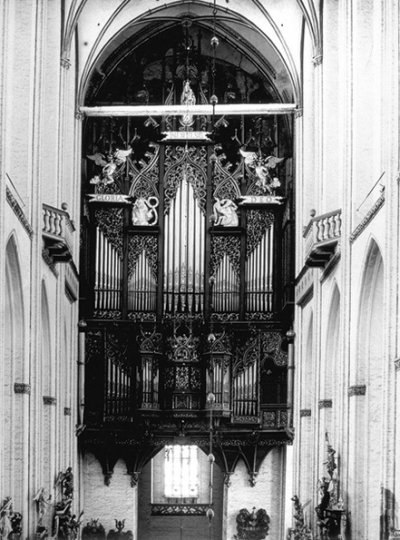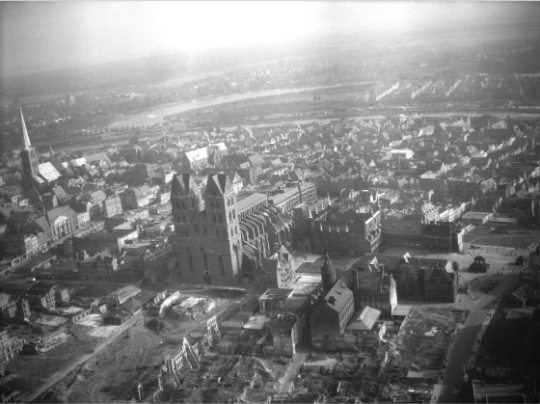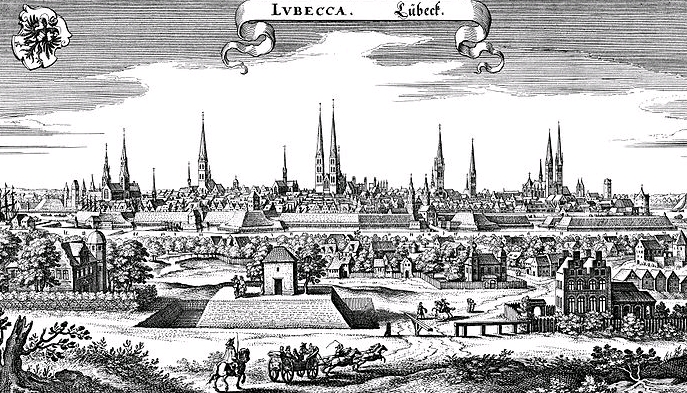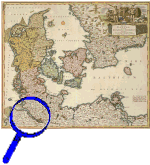|
|
||
|---|---|---|
|
|
|
|
|
|
||
1637 |
Dieterich* Buxtehude is born, probably in Helsingborg**, as the son of Johannes Buxtehude, by profession organist at the Lutheran Church of St. Mary’s, and his wife (about whom we don’t know anything). The exact date of Dieterich’s birth is not known, and even the year of his birth is based on calculations and not documented. Helsingborg is a wealthy Danish city on the Oresund and will be part of the Kingdom of Sweden a little later. The father is from the German city of Oldesloe (= Oldesloh, about halfway between Lübeck and Hamburg in the then Danish duchy of Holstein); the mother is possibly also of German extraction.
* This is the way he writes his given name. |
|
1641 |
In this year at the latest, Dieterich’s father, a distinguished musician, is appointed organist at the parish church of St. Olai in Helsingør, a city in Danemak that can be seen from Helsingborg across the Oresund, and is situated only about 50 km north of Copenhagen (= Koppenhavn). The fortress of Kronborg above Helsingør is a toll station for the merchant ships passing through the Sund and this accounts in part for the prosperity of the city. Dieterich’s mother must have passed on early in his life; in this year, his father marries for the second time, a Danish lady by the name of Helle Jaspersdaatter. Hardly anything is known about Dieterich’s early childhood years; we suppose that he speaks both Danish and German with his parents. Documents dating from his adult life and written in German attest that he is completely fluent in this language. |
|
1643 |
At the age of six he attends grammar school in the former Carmelite monastery where Latin is one of the subjects taught, as do the children of the better situated families of Helsingør. Singing and music theory are on the class schedule starting with grade 2; the school uses the demanding Heptachordum Danicum (in Latin) by Corvinus as text for the latter. Before religious holidays, the students on the church’s choir go caroling through the city to collect alms for the poor. |
|
1645 |
Dieterich’s half-brother Peter is born; from the register of baptism at St. Olai come some of the few clues we have concerning the Buxtehude family. In later years, at least two girls will be added to the family, Katharina and Anna, but their birth dates are not known. |
|
1649 |
In this year, the grand organ at St. Olai is restored by Johann Lorentz from Copenhagen who has become well-known both as a musician and for the organs he builds. One might think that little Dieterich is urged by his father to learn from the master, perhaps to serve as his apprentice. We see that Dieterich is growing up in a rich musical environment in which the music of theater and ballet is valued just as much as that of the church. This is possibly the consequence of the interest in the arts shown by the royal houses of Denmark and Sweden that are attracting and appointing the best qualified musicians from Italy, France and Germany. |
|
1657 |
No document exists that could inform us about Dieterich’s professional development. His biography by André Pirro (see below) lists a great number of competent organists and composers in the northern part of Germany, especially in Hamburg, and it is to be expected that a young student of music is aware of their names and perhaps also of the characteristics and distinctive features of their works. Beyond this, we can only guess if, and with whom, and for how long, he is taught by one of the great musicians But now, only twenty years of age, he enjoys his first professional appointment as an organist himself, at St. Mary’s in Helsingborg, the city where he was born. |
|
1658 |
Denmark has to cede Helsingborg and the surrounding province of Scania to the King of Sweden at the end of the Nordic Wars, but not even the peace of Röskild puts an end to the hostilities. Fortunately, Dieterich in Helsingborg and his father’s family across the Sund in Helsingør remain relatively untroubled by the war as also by the then raging pestilence epidemic. |
|
1660 |
Dieterich Buxtehude is elected organist at the Church of St. Mary in Helsingør, successor of Klaus Dengel who was enticed to go back to his home town of Schleswig. Dieterich’s salary is now three times higher than in Helsingborg and about sixty per cent greater than that of his father at nearby St. Olai. As the house reserved for the organist is badly damaged, Dieterich, not yet married, moves in with his parents. He is now 23 years of age and a very well respected musician already; on his advice, the organ at St. Mary’s is completely refurbished, at considerable expense, in the years to follow. A single composition is known with certainty to date from DB’s time in Helsingør, the cantata Aperite mihi portas justitiae (BuxWV 7*). * The numbering of Buxtehude’s works follows the index given by Georg Karstädt (see below) and is not chronological. |
|
1667 |
The organist at the Church of St. Mary’s in Lübeck, Franz Tunder, dies in a high fever. Dieterich applies for the position with two other candidates and presents himself and his art to the magistrate of the city in December. He is appointed to the position. 
Lübeck: The church of St. Mary’s (built between 1250 and 1350),
before 1928.
|
|
1668 |
On April 11, Dieterich Buxtehude is officially inducted organist at St. Mary’s in Lübeck, thus again at a church dedicated to Holy Mary. The principal organ of the church is a particularly beautiful instrument and has, with 3 manuals and pedal, a total of 54 sounding registers. With this appointment, DB receives twice the salary he earned in Helsingør 
The grand organ at the western wall of the St. Mary’s in Lübeck, built between 1516 and 1518, as of 1932. Shortly thereafter, he takes the oath as a burgher of the Free Imperial City of Lübeck which brings with it the obligation to serve in the city’s militia. The city is a member of the Hanse, a wealthy trade association of cities that has become an international economic power. However, Lübeck has lost some standing with the gradual decline of the Hanse due to the continuous state of war in Northern Europe and principally between Denmark and Sweden. The city is now surrounded by Swedish and Danish territories and its inhabitants must therefore remain vigilant and keep the fortifications in good repair, at the cost of high taxes. A contemporary report states that the citizens of Lübeck are ultra conservative, status-conscious and xenophobic. On August 3, Dieterich Buxtehude marries Anna Margaretha Tunder, the daughter of his predecessor Franz Tunder; the bride is two years older than the groom. There is no paper suggesting that the marriage was a condition for obtaining the job as organist at St. Mary’s although this type of arrangement was not unusual at the time. At any rate, the church obliges Dieterich to pay about one-third his salary for the support of his mother-in-law and her two unwed daughters. The French composer François Couperin is born this year. |
|
1669 |
Anna and Dieterich’s first child is born, Magdalena Elisabeth. The Tunder and Buxtehude families get along quite well. Dieterich is actually an amiable man who is well liked also by the musicians the city employs to perform at official functions. He has success in finding sponsors who contribute to performances of major works of music and, following his suggestions, two galleries are built high on the side walls of the nave of St. Mary’s which provide space for supplementary singers and musicians. |
|
1670 |
DB’s secondary function at St. Mary’s is that of “work master”, a job comparable to superintendent and entailing major administrative duties. As he is prudent and judicious in exercising this assignment, magistrate and church council let him have a relatively free hand and honor his expenses for purchasing instruments and sheet music, or for the remuneration of musicians and singers he hires for grander performances. On special occasions, up to three dozen musicians complement the seven employed by the city. The first of Buxtehude’s secular compositions we know of appears to be the canon Divertissons-nous aujourd’hui, beuvons, beuvons, beuvons (BuxWV 124), written into the memory album of an important citizen. |
|
1671 |
More of Dieterich Buxtehude’s works become known and are copied as his reputation grows (and more of them are therefore passed down to us), as e.g. the cantata Mit Fried und Freud ich fahr’ dahin (BuxWV 76). We can establish a chronology of his works little by little, and the most important ones are mentioned in the following. A second daughter, Margaretha, is born. |
|
1672 |
DB writes the aria Auf, stimmet die Saiten, Gott Phoebus tritt ein (BuxWV 116) for the wedding of the mayor of Lübeck. Anna Sophia is born, Anna Margaretha and Dieterich’s third daughter. |
|
1673 |
In this year, Abendmusiken (literally, evening musics) at St. Mary’s are given for the first time since Dieterich Buxtehude took office, i.e. a series of performances outside the liturgy on the five Sundays before Christmas. Franz Tunder had introduced these presentations, in a slightly different format, before 1646 already; Dieterich now resumes the tradition with great success. Surviving programs show that the concerts are extensive and expensive. Admissions charges are minimal, the greater part of the cost is covered by the merchant associations and the trade guilds. The city of Lübeck and her virtuoso organist become famous with these performances. |
|
1674 |
Dieterich’s father Johannes dies at the age of 70 and is entombed in the church of St. Mary. The cantata Fried- und freudenreiche Hinfahrt des alten grossgläubigen Simeons (BuxWV 76), written 3 years earlier, is performed at this sad occasion. Dieterich dedicates the four-voiced Canon duplex per augmentationem (BuxWV 123) to the young organist Johann Valentin Meder (* 1649). |
|
1675 |
The fourth daughter is born and is given the name of her mother. |
|
1676 |
Two important works of Dieterich Buxtehude’s date from this time: the cantata Jesu dulcis memoria (BuxWV 57), composed in Italian style (and commented extensively by his biographer Pirro), and then the very successful oratorio Die Hochzeit des Lamms (BuxWV 128), an evening concert for large ensemble; we have only the libretto of the latter, possibly written by Buxtehude himself. The first performance of the oratorio is so lavish and costly that DB has to request an allocation of funds from the church to cover the deficit. |
|
1677 |
Especially moving is Jesu, meiner Freuden Meister (BuxWV 67), a cantata offering solace and comfort to the parson of a parish near Rostock whose wife has passed on. |
|
1678 |
A fifth daughter is born and is given the name Anna Sophia, like the one born in 1672 and has died. |
|
1680 |
Dieterich Buxtehude writes a series of seven cantatas, one for each part of the crucified body of Jesus Christ; he dedicates the complete oeuvre, Membra Jesu nostri (BuxWV 75), to Gustav Düben, the Kapellmeister or director of music at the court of the King of Sweden in Stockholm. It is due to this gentleman that a large part of Buxtehude’s work still exists. For the wedding ceremony of the King of Sweden, DB composes the aria Klinget für Freuden, ihr lärmen Klarinen (BuxWV 119), possibly on the suggestion of Gustav Düben, and dispatches it to Stockholm. |
|
1681 |
Three cantatas by Dieterich Buxtehude from this year have survived in the Düben collection, written in tablature*: Sicut Moses exaltavit serpentem (BuxWV 97), O dulcis Jesu, o amor cordis mei (BuxWV 83), and Gen Himmel zu dem Vater mein (BuxWV 32), among other works, e.g. the lengthy aria for a wedding Schlagt, Künstler, die Pauken und Saiten (BuxWV 122). One should not conclude from this that Buxtehude has a particularly productive year but rather that his music is ever more appreciated and respected by the public and his colleagues alike and that it is therefore more widely distributed through print and handwritten copies. * Tablature is a type of musical shorthand in which the notes are not written on lines as is nowadays common practice (“staff notation”) but are expressed in letters or numbers specific for a given instrument. |
|
1683 |
The Düben collection in Uppsala/Sweden contains a whole series of Buxtehude’s works, most of them sacred music copied in this year and thus probably written shortly before, e.g. the cantatas BuxWV 11, 48, 49, and the motet BuxWV 113 for six choirs. |
|
1685 |
This is the year in which Johann Sebastian Bach is born (in Eisenach/Germany) and Georg Friedrich Händel (in Halle an der Saale/Germany). DB dedicates a Canon quadruplex a 5 (BuxWV 124a) to his celebrated composer colleague Johann Adam Reincken in Hamburg (1623-1722) as a “Prize of Immortal Honor”. |
|
1687 |
In a letter of thanks and appeal to his sponsors, the Board of directors of guilds and trading societies, Dieterich Buxtehude states with regret that the moneys collected for the evening concerts no longer bring the amounts required. The weekly entries in the church’s work- and account books (of which pertinent excerpts are given in the biography by Snyder, see below), his responsibility, show that maintenance and repair of the organ at St. Mary’s cost the parish a considerable amount of money each year. By the way, the only one of Dieterich’s trips documented while he is holding the job in Lübeck brings him to Hamburg where he discusses the state of the organ in St. Mary’s with the master organ builder Arp Schnitker and also tries out the organ in the Nikolai-Kirche, recently renovated. This comes out of the application he submits to be reimbursed for the trip and four days’ stay in Hamburg. All through these years, he and his friend and colleague Johann Adam Reincken in Hamburg are visited by many musicians, students and professionals alike, and this attests, and pays tribute, to the fame of the two masters in the arts of composition and improvisation. The free treatment of a musical theme was already customary in both the catholic and protestant liturgies since about 1550, at least during that part of Holy Mass called consecration. |
|
1688 |
Like many other works by DB written for his evening concerts, Der verlorene Sohn (BuxWV 131), performed during Advent, is no longer in existence. The cantata O clemens, o mitis, o coelestis Pater (BuxWV 82) is possibly part of this «Abendmusik. Out of the total number of compositions by Buxtehude, only a few can be dated with any degree of certainty and therefore the opinion of his biographer Pirro, namely that his productivity declines from now on, is hard to sustain. |
|
1689 |
Regrettably, Gustav Düben, the composer and musical director at the court of the King of Sweden, Buxtehude’s friend and avid collector of his works, dies toward the end of this year. |
|
1694 |
Publication of seven sonatas for violin, viola da gamba and cembalo (first part, BuxWV 252-258), by Nicolaus Spiering in Hamburg. |
|
1695 |
Dieterich Buxtehude composes the cantata Deh credete il vostro vanto (BuxWV 117) for the wedding of a prominent Lübeck citizen. |
|
1696 |
Publication of seven more sonatas for violin, viola da gamba and cembalo, the second part of a series (BuxWV 259-265). |
|
1698 |
Creation of the aria Opachi boschetti (BuxWV 121) for the wedding of a mayor. |
|
1699 |
The composer and master organist Johann Pachelbel in Nürnberg (= Nuremberg), * 1623, dedicates his Hexachordum Apollinis, a collection of variations on seven musical themes for the organ, to Dieterich Buxtehude. |
|
1700 |
A rich program is planned for this year’s evening concerts and is submitted, with the complete lyrics, to the magistrate and the church council already in January, for approval and possibly including a request for financing. Unfortunately, neither text nor music has survived the times (BuxWV 133). |
|
1701 |
The minutes of a meeting of St. Mary’s parish council state that workmaster Buxtehude has lodged a complaint about the condition of the grand organ which (according to him) “... had not been repaired in 50 or 60 years, is covered in dust and has many defects ...”. This contradicts somewhat his own reports about repairs and costs entered in the work books over the years. |
|
1703 |
The 22-year old Johann Mattheson of Hamburg and the 18-year old Georg Friedrich Händel of Halle/Germany, good friends and both talented and versatile musicians, follow the magistrate’s invitation to come to Lübeck to present themselves, look around and audition as possible successors of the aging Buxtehude. Neither of the young masters, however, is prepared to marry Dieterich’s daughter Magdalena Elisabeth, * 1669, a condition for being hired. |
|
1705 |
Toward the end of October, Johann Sebastian Bach arrives in Lübeck on foot from Arnstadt in Thuringia/Germany (a distance of 450 km or about 280 miles), to listen to Dieterich Buxtehude’s artistry and especially to attend his evening concerts. The council of the Neue Kirche in Arnstadt, where he has held the position of organist now for about two years, has granted him a leave of absence of four weeks. JSB is a young man of 20, in Arnstadt comparatively very well paid and happy with the Wender organ; it does not appear likely that he intends to apply for Buxtehude’s job in Lübeck but he must have known that the time of four weeks allotted to him for the trip is not sufficient. Be that as it may, he returns to Arnstadt only on February 7, 1706, and has to explain the highhanded prolongation of his absence to the consistory. However, he enjoys already such respect as a musician that the excursion has no further consequences for his employment.* * A most interesting account of Johann Sebastian Bach’s voyage to Lübeck and Buxtehude’s influence on his music is given in the great Bach biography by Philipp Spitta (in German; Breitkopf & Härtel, Leipzig, 1873, 4th edition of 1930, vol I, pp 258 ff). [In 2005, the Leipzig musicologists Michael Maul and Peter Wollny found in the Herzogin Amalia-Bibliothek in Weimar several fascicles with chorales in tablature notation of which one, Nun freut euch, lieben Christen g’mein by Dieterich Buxtehude has without a doubt been copied by the about 13-year old Johann Sebastian Bach*. We see that the young JSB knew and treasured works by the great Lübeck organist already then, when he lived with his brother in Ohrdruf. *Michael Maul, Peter Wollny, ed.: Weimarer Orgeltabulatur (in German). Bärenreiter-Verlag, Kassel: 2007] On the occasion of the death of Kaiser Leopold I, Buxtehude’s oratorio Castrum doloris (= Bed of Suffering, BuxWV 134) is given as an evening concert with great pomp in St. Mary’s; the music no longer exists. The shorter work Templum honoris (= Temple of Honor, BuxWV 135) follows the next day, it is probably meant to congratulate Kaiser Joseph I at the accession to the throne. Unfortunately, neither the music nor the lyrics of this work remain. The last known composition by Dieterich Buxtehude is the arietta O fröhliche Stunden, o herrlicher Tag (BuxWV 120) for the wedding ceremony of a mayor of Lübeck. |
|
1706 |
Almira, the first opera by Georg Friedrich Händel, has its premiere performance, in Hamburg. The great composer and organist Johann Pachelbel (* 1653) dies in March. |
|
1707 |
Death comes to Dieterich Buxtehude on May 9; he is 70 years old. The cause of death is not known. He is buried in St. Mary’s in Lübeck. Of seven daughters, only three survive their father; Anna and Dieterich had no sons. In June, Johann Christian Schieferdecker is appointed Buxtehude’s successor; he marries Dieterich’s daughter Anna Margaretha shortly thereafter. |
|
1722 |
The composer Johann Adam Reincken dies in 1722. Following the request in his last will and testament, he is buried right next to his friend Dieterich Buxtehude in St. Mary’s, the only man he finds worthy of this sign of respect. |
|
|
The city of Lübeck (above this brief biography) as seen by Matthäus Merian (1593-1660) in 1641. On the mound in the center of the city stands the twin-towered Church of St. Mary, constructed between 1250 and 1350. Dieterich Buxtehude worked here as an organist from 1668 until his death on May 9, 1707. |
||

Lübeck: St. Mary’s church, city hall and historic city center,
|
||
Recommended reading |
||
|
|
Georg Karstädt: Thematisch-systematisches Verzeichnis der musikalischen Werke von Dietrich Buxtehude. Breitkopf & Härtel, Wiesbaden: 1985 (in German) Hans Joachim Moser: Dietrich Buxtehude. Verlag Merseburger, Berlin: 1957 (in German) André Pirro: Dietrich Buxtehude. Librairie Fischbacher, Paris: 1913. Nachdruck: Minkoff Reprint, Genève: 1976 (in French) Kerala J. Snyder: Dieterich Buxtehude. Leben, Werk, Aufführungspraxis. Bärenreiter-Verlag, Kassel: 2007 (in German, newly edited and appended translation of the original in English) |
|

|
Click here to listen to the Suite in A major, for piano, by Dieterich Buxtehude (BuxWV 243) with the movements Allemande, Courante, Sarabande, and Gigue. |
|
|
I am very grateful for the help given me by the ladies and gentlemen of the Municipal Library in Lübeck/Germany in my search for the works of Dieterich Buxtehude.
|
||



